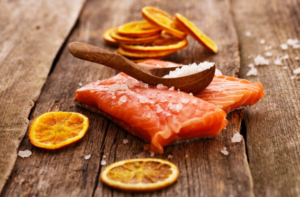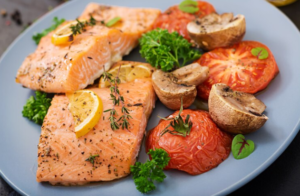A single serving of canned salmon contains more calcium than a glass of milk! As a nutritionist, I’m always amazed by how many people overlook this affordable superfood.
While fresh salmon gets all the glory, canned salmon quietly packs the same impressive nutritional punch – and sometimes even more! Last year, the American Heart Association reaffirmed canned salmon as one of the best heart-healthy protein sources you can buy.

Canned salmon nutrition facts.
Canned Salmon Protein Content Per Can
Canned salmon is rich in quality proteins. On average can of salmon meat delivers about 20 grams of protein in average. This quantity is recommended for usage by athletes due to its impact on muscle repair, immune defenses, and even general body maintenance. This complete protein contains all nine essential amino acids which makes it fit the specific dietary profile of many people who watch their nutrition.
Concentrations of Omega-3 Fatty Acids.
Canned salmon is extremely high in omega-3 acid particularly EPA and DHA which have direct links to supporting heart wellness as well as brain health. In just a 3-ounce serving, up to 1000 mg can be obtained which is almost a third of the recommended daily intake which plays an important role in anti-inflammatory activity and enhancement of cardiovascular health.
Vitamins D and B complex
Among its many advantages, canned salmon is a fantastic source of vitamin D that is helpful for bone, immune, and mood-related health. Salmon also provides B vitamins which include B12, Niacin, and B6 which are important to the body for energy, the brain, and even red blood cells.
Mineral Content (Calcium, Selenium, Potassium)
Most Canned salmon’s calcium benefit stands out in comparison to other types and their calcium never really is that special unless they’re made with bones. One serving can provide nearly a fifth of what is required, thus thumbs up for bone health. But canned salmon also has high levels of an antioxidant in selenium, and also potassium which is useful for the heart.
Calories & Fat Content Comparison
It’s also healthy and has very few calories compared to other fish. A serving usually averages about 130 calories no more but the fats contained are of a healthy type with omega three providing 100 percent nutrition for the balanced eater. Canned salmon is Perfectly balanced in its nutrition and macronutrient ratio.
2. Canned Salmon Nutrition Facts: Health Benefits
Heart Health Advantages
Canned salmon, since it is also rich in omega-3 fatty acids helps provide advantages to consumers as it is good for the heart, this is because it decreases blood pressure, lowers triglycerides as well as decreases the risk of arrhythmias. The risk of developing heart disease decreases significantly due to regular consumption of omega-3-laden products like salmon.
Brain Function Support
Canned salmon contains omega-3 fatty acids such as DHA, which help to improve memory and other specific brain parts. According to research, omega-3 fatty acids offer numerous benefits and it ranges from age-related memory issues to general mental health problems.
Bone Health Benefits (Especially with Bones Included)
Calcium and vitamin D are both needed to prevent bone muscle loss as well as retain bone density. Canned sardines are also good and they have been classified into omega-3 types which supply these nutrients and minerals to the consumers. A narrow diet leads to burnout for hard muscles that encourage holistic healthy bodies.
Anti-Inflammatory Properties
Canned salmon contains omega-3s and this is useful in decreasing chronic inflammation which is caused by diseases like arthritis, heart disease, and even cancer. Including meals with anti-inflammatory properties can do as good as if you take fish like salmon.
Weight Management Benefits
The well-known advantages of canned salmon can be attributed to its protein and fat content which are known to be active and helpful in losing weight. It is also a nutrient-dense food that is low in calories which benefits weight loss while ensuring that nutrition requirements aren’t compromised.
3. Canned vs. Fresh Salmon: Which One is Better?
Retention of nutrients
Although fresh salmon consists of nutcomparable nutrients salt salmon supplements protein, omega-3s, and vitamins with comparable amounts due to its minimal processing. One cannot lose many nutrients as the canning process preserves them on a high level.
Cost/Budget
Canned salmon can be purchased at a low cost and many families prefer it over fresh salmon as it provides them at a cheaper rate as they don’t have to pay for fresh cuts. So canned salmon is excellent in terms of price benefit analysis.
Convenience of Use
Canned salmon is prepared and all one has to do is consume it so it saves time for the consumer in one demographical area. It is perfect for those who are active, as they can eat on the go without the worry of preparing food.
Advantages of durability
When it comes to canned salmon, you can expect a durability of five years and that is when the can hasn’t been opened. This is a nice ingredient to have in your closet that prevents waste and at the same time assures that you will have a healthy snack.
The Canning Procedure and Its Effects on Salmon
Though the canning process might require some heat treatment, research indicates that there is good retention of most nutrients, especially omega-3s, and protein. This small nutrient loss makes canned salmon an option that is nearly as good as the fresh ones.
4. Types of Canned Salmon and Their Health Values
Wild Caught vs. Farmed
Canned wild-caught salmon generally has higher omega-3s and low levels of toxins compared to farmed salmon. These differences in nutrition are also observed in the sales of canned salmon whereby wild-caught salmon usually has a much greater emphasis in marketing than the farmed one.
Pink vs. Sockeye Salmon
Pink salmon is more commonplace for canning purposes and has a more subtle flavor with less fat content, while sockeye is richer in taste and has more omega-3s. Both are nutritious with sockeye salmon having a slight edge on omega-3 content and taste.
Bone-In vs. Boneless
Bone-in canned salmon includes additional mineral calcium, hence it is ideal for consumers who seek to enhance their bone density. Boneless alternatives do contain all other nutrients except calcium which would have come from the soft, consumable bones.
Different Packing Approaches (Water Vs Oil)
Water-packed canned salmon has fewer calories and contains more natural fish oils than oil-packed salmon which may have higher calories. For those on calorie restriction, water-packed canned salmon would quite be suitable, and oil-packed may add more flavor.
Different Processing Methods
There are some canned salmon which is not thoroughly processed in tointain texture and flavor. If you want to avoid consuming artificial items, seek those which specify “minimally processed” or “without additives.”
5. Possible Health Issues And Considerations
Mercury Concentration And Safety
Salmon typically has lower levels of mercury than most fish which makes canned salmon a safer option. However, it is still best to eat healthy and balanced meals and avoid large servings if you have mercury sensitivity issues.
Awareness About Sodium Intake
Other brands could however add salt and so some added sodium could be expected. Low-sodium-packed salmon should be selected to limit unnecessary salt intake, especially for those suffering from elevated blood pressure.
BPA in Can Linings
BPA is found in the linings of many canned foods and can get into food. Reducing exposure to this chemical can be done by using cans with a BPA-free labeled seal.
Allergies and Sensitivities
Individuals with fish allergies should steer clear of salmon, and if you have other allergies, it is best to check ingredient labels.
Recommended Serving Sizes
One can serve 3 to 4 ounces to benefit from the nutritional purposes of canned salmon. This is supposed to be eaten in moderation, all in 2-3 servings per week, in the context of a varied diet, for optimum health benefits while avoiding overconsumption.
6. Best Ways to Include Canned Salmon in a Healthy Diet
Quick Healthy Recipe Ideas
There’s always an option to put canned salmon right into salads or in a salmon pattie or other dishes straight mixed into the pasta. For a snack, combine it with whole-grain crackers, or spread it on whole-grain toast with avocado.
Proper Storage Guidelines
Canned salmon in an unopened state should be placed away from humidity and heat sources, as it will keep for a few years. If you have leftover food after meals, put them in a covered container and keep them in the fridge, eating within 2-3 days.
Serving Suggestions
Fresh canned salmon can also be tossed on roughly chopped greens, in a grain bowl, or on baked potatoes as a protein topping. This can also be used for making salmon cakes or salmon salad for placing in a sandwich.
Meal Planning Tips
Canned salmon is an easy protein resource that combines with other many food items. This can also be used in advance for lunch or quick tasty dinners.
Considerations in Dietary Restrictions
Canned salmon can be eaten by those who are gluten intolerant, paleo dieters, or those on the keto diet. In case of specific dietary requirements, select options without any added ingredients like wheat or soy to meet your ideal protein requirements without the risk of transgressing in the diet.



Resources such as the one you mentioned right
here will be extremely useful to myself! I will publish a hyperlink
to this page on my particular blog. I am sure my site visitors will uncover that fairly useful.
https://webmaster.xmc.pl
Hi my loved one! I want to say that this post is amazing, great written and
include approximately all vital infos. I’d like to see more posts
like this .
My webpage :: ole einar bjørndalen
I had this page saved some time before but my PC crashed.
I have since gotten a new one and it took me a while to come across this!
I also in fact like the design though.